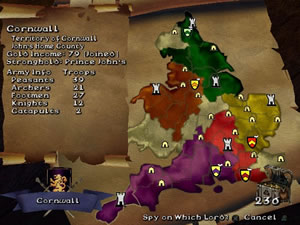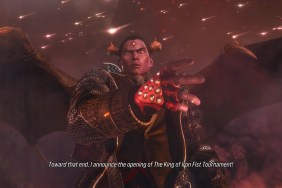An arrow through the heart.
We have an original Pong machine here at GR, and a few years
ago we tried to use it to solve office disputes. Think that very last Mountain Dew in the fridge should rightfully be yours? Take it to the Pong! It
seemed the perfect solution. Plus it was old-school, and in these retro times
that makes it cooler than a Klondike bar.
After about five minutes, we switched to Virtua
Tennis.
The
fact is, Pong sucks. I know, I know, it was a monumental, innovative
step in the history of interactive entertainment. But unless you’ve turned on
an old Pong machine lately and stared at that fat stupid pixel
slowly meandering back and forth across the screen, just daring you to pass
out from sheer boredom, you’re clearly looking at history through rose-colored
glasses.
But you’re not alone. An obsessive defense mechanism for classic games is
seemingly hardwired into gamer DNA, which might explain why we constantly glorify
old games and almost always consider them better than new ones. We’re often
wrong.
Case in point: Robin Hood: Defender of the Crown. A remake
of the somewhat classic computer strategy game from 1986, this game proves that
success cannot be duplicated with a new graphics engine. What was good in the
past often winds up mediocre in the present, though Robin Hood
barely even manages that.
Robin Hood puts you in the smelly boots of the anarchist
archer himself. King Richard is stuck in a dungeon overseas, his evil brother
Prince John has usurped the throne and England is in turmoil as various lords
battle for control of the country.
The game is an odd mix of genres, sort of a mix between the turn-based strategy
games Risk and Heroes of Might & Magic. After
a brief tutorial in Sherwood Forest, you’re spit out into a big map of England,
broken up into about 50 regions. Each produces a certain amount of gold every
day and a few have other strategic value, such as lowering the cost of a certain
unit. Six other lords start off with one region apiece, and it’s up to you to
gobble up land, defeat the other lords and ultimately show John exactly what
you think of corrupt nepotism.
You’re not alone in your endeavor, however. Five members of Robin’s merry
gang act as supervisors and can be used to undertake different tasks. In conjunction
with basic map control strategy, these five are crucial to victory.
As Robin, you can raid castles or caravans for extra gold. The castle raids throw you into very rickety side-scrolling arcade sword-fighting sequences in which you must beat up some guards before time runs out. The more you kill, the more money you get. It’s a good idea, but they forgot to make it fun. The fighting is incredibly basic and the control is unresponsive, with a dumb combo system and redundant attacking and defending.
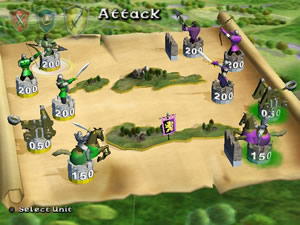 Caravan
Caravan
raids fare little better, placing you in a first-person perspective as you shoot
arrows at passing guards on horseback for cash. You’re up in a tree and don’t
move, making it an awkward target practice as you don’t get any sort of crosshairs” not that this would help much, though.
The good knight Wilfred of Ivanhoe is used to fortify your land by building
protective castles or calling a tournament, which is a series of jousts for
land, cash and fame. Like Robin’s raiding, the jousting is overly simple and
not very fun, employing the old Track and Field button-mashing
technique. You don’t control the horse or the direction or anything at all aside
from speed and aim.
The bulk of the action is seen by Little John, who commands the armies and
battles that make up most of Robin Hood‘s map conquest. Unfortunately,
even this is too bland in its design to merit much value. You can only recruit
five kinds of units and have only one active army (much like the old King’s
Bounty). There’s also an annoying cap on how big your army can get, so even
if you can afford to build a massive legion, the game won’t let you.
The battles themselves take place on little boring 2D maps and play out in
real-time. You frantically select one your five unit types and send them down
one of three paths to wipe out the bad guys. The unit balance is bad, as you can
vanquish big armies with just a large squad of archers while the more expensive
knights always seem to take it in the faceplate.
Things get slightly more amusing during castle sieges. Here you have to rotate
the analog sticks to fire catapult blasts at four enemy walls as quickly as
you can before rushing into battle, else the enemy will be protected by little
walls during combat. It feels pretty good smashing down a wall and taking out
some garrisoned troops, but twirling a small stick is not much of a game.
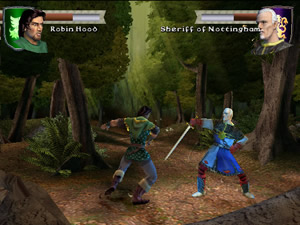 The
The
other two semi-helpful comrades are Friar Tuck, who just takes money to pay
off the king’s ransom, and Maid Marian, who acts as a spy. Send her into a region
and sooner or later you’ll find out what kinds of troops, if any, are there.
Boil all these diverse gameplay elements down and it sounds like a great,
varied experience’except none of them are very good. Playing Robin Hood
is often tedious, made even worse by the fact that after a few hours you’ll
only use Robin’s raiding during scripted events and will focus almost all of
your efforts on Little John’s combat.
That scripting is decent, at least. There are 8 different endings based on
how you perform; pay off the king’s ransom and save lots of damsels and you’ll
get a good ending, while just beating up John but not engaging in side events
will lead to a less decisive victory. It’s a nice touch, but one that is wasted
on the bland gameplay.
After you get one of those endings (which should take about 5 hours), you
won’t want to try for another one because there is only one mode of play and
one map. You’ll have to go through the story again, this time skipping all the
cut scenes, and try the exact same map again with different start locations.
Robin Hood might be the first strategy game I’ve played with
almost zero replay value. That’s sort of the whole point of a strategy game,
isn’t it? To play it over and over and perfect your strategies? Chess,
anyone?
The game doesn’t even look very good, featuring boring textures and cheap
character models. The best effects take place during the sieges as walls crumble
and troops go flying, but the combat just shows little icons guys moving around
a brown map. Nearly 20 years have passed, yet they barely
changed a thing about the look.
What it lacks in graphics it does make up for in its sound. Solid orchestration brings the world a little life, and mature, authentic voices offer a nice respite from the often cartoony teenage heroes we get in too many console games.
Which might be the reason this game is no good ” it’s a dated PC game ported
to a next-gen console instead of a totally revised, retooled product. The folks
at Cinemaware may have had their finger on the gaming pulse 20 years ago, but
now they’re just living in the past. And so will you if you spend any money
on Robin Hood. Instead, maybe you should steal it and give
it to the poor as a tax write-off.
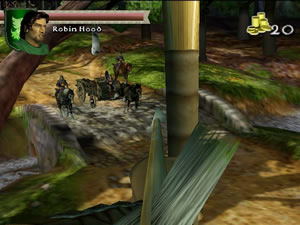
-
Good audio
-
Nice gameplay variety
-
But boring gameplay
-
One mode?
-
Short
-
Very little replay value
-
Shoddy graphics
